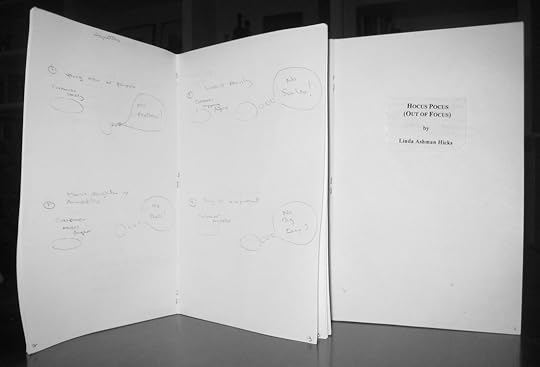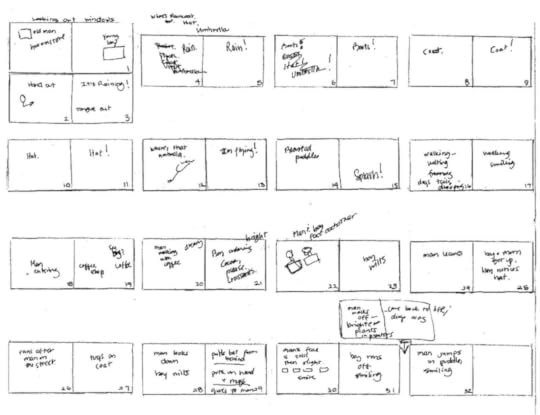Linda Ashman's Blog, page 5
November 5, 2013
Bad Beginnings
Ever write a first draft that's so sketchy, nonsensical and just plain pathetic that you think there's no hope you'll get a decent--much less salable--manuscript out of it? That pretty much describes all my first drafts. And yet some of them do manage to get transformed into actual stories and--eventually--wind up as books. As November's featured author for
Julie Hedlund's
12 x 12 program (write 12 picture books in 12 months), I share some of my ugly early drafts for Creaky Old House, and offer ten tips for getting
Beyond the Bad Beginning
. Please stop by. And while you're there, be sure to sign up to
join the 12 x 12 community in 2014
.
Published on November 05, 2013 07:00
October 8, 2013
The Wisdom of Making Dummies
Yes, it's smart to make dummies. Why? Because they give you an excellent sense of how your story will work as a typical 32-page picture book. In The Nuts and Bolts Guide to Writing Picture Books, I show three ways that I make dummies. For those of you who haven't read the guide (or are reading it on a smallish electronic device on which the images don't show up as well), I've included the pictures below.
Here's the fold-and-staple approach I learned from editor Steph Lurie after she acquired Maxwell's Magic Mix-Up --originally called "Hocus Pocus (Out of Focus)" as you can see below-- one of the first manuscripts I sold. The story was too long, so making the dummy helped me trim it to picture book length.
This dummy uses nine sheets of paper. The outer page is the book cover. Remember that the first few pages are for the dedication, copyright and title, so your story typically begins on page 4 or 5.
 Here's the storyboard approach I used for Rain!:
Here's the storyboard approach I used for Rain!:  And here's the two-column table approach I used for Starry Safari and other books.
And here's the two-column table approach I used for Starry Safari and other books.  Which one works best? For me, it depends on the story. I like using the storyboard for wordless manuscripts, but appreciate the book-like feel of the fold-and-staple dummy. Make whichever one most appeals to you. I guarantee it will help you with your manuscript.
Which one works best? For me, it depends on the story. I like using the storyboard for wordless manuscripts, but appreciate the book-like feel of the fold-and-staple dummy. Make whichever one most appeals to you. I guarantee it will help you with your manuscript.
Here's the fold-and-staple approach I learned from editor Steph Lurie after she acquired Maxwell's Magic Mix-Up --originally called "Hocus Pocus (Out of Focus)" as you can see below-- one of the first manuscripts I sold. The story was too long, so making the dummy helped me trim it to picture book length.
This dummy uses nine sheets of paper. The outer page is the book cover. Remember that the first few pages are for the dedication, copyright and title, so your story typically begins on page 4 or 5.
 Here's the storyboard approach I used for Rain!:
Here's the storyboard approach I used for Rain!:  And here's the two-column table approach I used for Starry Safari and other books.
And here's the two-column table approach I used for Starry Safari and other books.  Which one works best? For me, it depends on the story. I like using the storyboard for wordless manuscripts, but appreciate the book-like feel of the fold-and-staple dummy. Make whichever one most appeals to you. I guarantee it will help you with your manuscript.
Which one works best? For me, it depends on the story. I like using the storyboard for wordless manuscripts, but appreciate the book-like feel of the fold-and-staple dummy. Make whichever one most appeals to you. I guarantee it will help you with your manuscript.
Published on October 08, 2013 07:28
September 21, 2013
An Introduction
I chose this domain name -- How to Write Picture Books -- because I wanted to make it easy for picture book writers who are just starting out (or are further down the road, but not quite as far as they'd like to be) to find me, and to get some help and encouragement for their journey.
In truth, the domain name should be "My Approach to Writing Picture Books" because, of course, there's not just one way to do this. But that was a bit cumbersome. Plus, even though my way is not the only way, I do think it will help anyone who's serious about writing picture books.
So what is my approach, exactly? I believe in learning from experts – in this case, writers and illustrators who are smart, clever, and creative and do things really well. So when I teach workshops, I share parts of many excellent picture books to illustrate certain concepts—things like voice, story escalation, strong beginnings, satisfying endings, rhyme, character, and more.
I take the same approach in The Nuts and Bolts Guide to Writing Picture Books. I use lots of examples to show how to, say, add humor to your story, enliven your narrative voice, or find your way through the murky middle of your manuscript. Then I offer exercises so you can play around with these ideas yourself and apply them to your works-in-progress.
I learned to write picture books by reading them, by reading about how to write them, and by picking up tips at the occasional conference I attended. I got stacks of books each week from the library (still do), and bought every "how to" book I could get my hands on. I wrote lots of dreck, made dumb mistakes, and got nothing but rejections for two years. But I kept reading and writing and learning. Eventually I sold my first manuscript, then another, then 10, then 20, then 30 . . .
I wrote the Nuts and Bolts Guide to help others avoid making some of the mistakes I made and skip ahead to the more satisfying parts – creating and completing a compelling, well-constructed manuscript, and selling it to a publisher so that (in time—this stuff doesn’t happen quickly) you can hold a beautiful, well-made picture book in your hands.
I’ll be adding more to this website over time. I hope you’ll visit again soon.
In truth, the domain name should be "My Approach to Writing Picture Books" because, of course, there's not just one way to do this. But that was a bit cumbersome. Plus, even though my way is not the only way, I do think it will help anyone who's serious about writing picture books.
So what is my approach, exactly? I believe in learning from experts – in this case, writers and illustrators who are smart, clever, and creative and do things really well. So when I teach workshops, I share parts of many excellent picture books to illustrate certain concepts—things like voice, story escalation, strong beginnings, satisfying endings, rhyme, character, and more.
I take the same approach in The Nuts and Bolts Guide to Writing Picture Books. I use lots of examples to show how to, say, add humor to your story, enliven your narrative voice, or find your way through the murky middle of your manuscript. Then I offer exercises so you can play around with these ideas yourself and apply them to your works-in-progress.
I learned to write picture books by reading them, by reading about how to write them, and by picking up tips at the occasional conference I attended. I got stacks of books each week from the library (still do), and bought every "how to" book I could get my hands on. I wrote lots of dreck, made dumb mistakes, and got nothing but rejections for two years. But I kept reading and writing and learning. Eventually I sold my first manuscript, then another, then 10, then 20, then 30 . . .
I wrote the Nuts and Bolts Guide to help others avoid making some of the mistakes I made and skip ahead to the more satisfying parts – creating and completing a compelling, well-constructed manuscript, and selling it to a publisher so that (in time—this stuff doesn’t happen quickly) you can hold a beautiful, well-made picture book in your hands.
I’ll be adding more to this website over time. I hope you’ll visit again soon.
Published on September 21, 2013 11:51
August 2, 2013
Working on a Picture Book Manuscript?
Hi there.
This website will be expanded over time, so look for more information about writing picture books here soon. In the meantime, if you've got questions, things you'd like to know about, please write a comment. Thanks!
This website will be expanded over time, so look for more information about writing picture books here soon. In the meantime, if you've got questions, things you'd like to know about, please write a comment. Thanks!
Published on August 02, 2013 14:23
June 4, 2013
Rain! Giveaway
Houghton Mifflin Harcourt is giving away four autographed copies of RAIN!. Visit this page to enter.


Published on June 04, 2013 07:06
•
Tags:
giveaways, picture-books, rain
May 1, 2013
Peace, Baby! Giveaway
Thanks to all who entered the Peace, Baby! giveaway, which ended this morning, and congratulations to Brittany (in my state of NC), Stephanie (in OK), and Elise (in GA). I plan to do another one for Rain!, so stay tuned!




Published on May 01, 2013 06:40
•
Tags:
giveaways, peace-baby, rain
April 17, 2013
PEACE, BABY! Advance Copy Giveaway
Chronicle Books is giving away three copies of Peace, Baby!, which comes out April 23rd. Visit
this page
to enter.
Peace, Baby!
Peace, Baby!
Published on April 17, 2013 10:56
•
Tags:
giveaways



